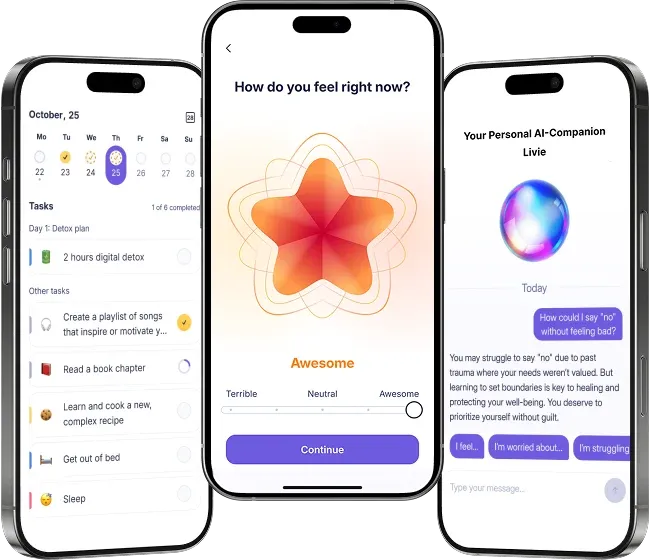Effective Stress Management: Practical Strategies for Everyday Life

Our lives are stressful — we were born in a messy universe. Family conflicts, job demands, academic responsibilities, health problems, and even the time of day can affect our mental health. We can work with some of these negative events, but most are just facts of life we have to get through. However, we can change how we feel about them. Stressful situations can trigger emotional reactions that, if unmanaged, can lead to mental health problems, influence our physical activity, increase our unhealthy habits, and delay our ability to maintain a healthy diet. But if you learn to regulate your emotions, the level to which stress affects you will be much more manageable. It's the best act of self-care.
Emotional regulation isn’t about changing our feelings or stifling them. No, it’s about managing emotions and learning to respond to situations in a healthier manner. Just like engineers find ways to direct an overflowing river and stop it from spilling, you can learn to handle your emotions and adjust your behaviors to the situation in front of you. Today, we will talk about how emotional regulation affects our long-term stress, what mental health conditions a lack of stress management can produce, and how to cope with stress on a day-to-day basis.
How Emotional Regulation Helps Manage Stress
Emotional control isn’t just about the aftermath of stress — you can become more adaptable and more confident, even in the moments of crisis. Learning how to manage stress contributes to our complementary and integrative health. Let’s imagine a hypothetical formula of our mental health under stress:
Stressful trigger => [Emotional regulation] => Stress outcomes.
Your emotional regulation is a buffer that can impact how you leave an unpleasant moment. Here’s how it could look in everyday life:
Person A is caught up in a dangerous road situation. Instead of panicking, they consider their exit strategies and leave the road before they end up in an accident.
Person B has a painful argument with their partner. Before they say something that they will regret, they get a hold of their emotions and meet their partner halfway.
These examples illustrate that, even when a situation is tough, we can save something (our relationships and ourselves) from it. That is, if we learn to direct our emotions in a useful direction.
On top of that, emotional regulation reduces the intensity of our feelings and makes it easier to recover from an overwhelming event. This gives us more resilience and saves us from chronic stress. We turn into creatures that don’t just react: we prevent, plan, and navigate our path through the most demanding moments. Our mental health is thriving. Isn’t that inspiring?
Furthermore, learning how to manage ourselves does something that many of us often regret not doing: it saves our relationships. Let’s be honest: how frequently do we lose close connections because we said something awful, something we didn’t even mean to? Whether at work or home, being able to navigate stress calmly fosters our emotional safety.
And so, it is evident that emotional regulation is essential in improving one’s overall well-being.
Signs of Poor Emotional Regulation in Stressful Situations
The first step toward growth is acknowledging that you’ve got a problem. Most individuals recognize that they struggle with emotional regulation but feel ashamed. If that’s the case for you, cut yourself some slack: it’s a skill you weren’t taught. We start this section with this reassurance so that you can be more honest with yourself while exploring these signs of poor emotional regulation.
Here are some common indicators, along with real-life examples:
Frequent Emotional Outbursts
This can happen not just in severely stressful situations but even in minor inconveniences. If your emotions often spill over the rim whenever you face a challenge or some discomfort, you tend to ignore the moment of the buildup. Even if you don’t mean to, you might react to the emerging issues with crying, yelling, or anger. Suppose you want to express your emotions once everything is cooled off and you are in a safe space. In that case, this doesn’t mean you struggle with regulation — quite the opposite, as giving yourself a chance to experience the feeling is a sign of emotional maturity. However, your self-management meter is a bit off if you can’t handle negative thoughts and tend to respond to them more radically than others.
Example: After receiving critical feedback about important tasks at work, a person might slam their laptop shut, shout at a coworker, or storm out of the room.
Difficulty Calming Down
How fast do you go back to your normal state after being overwhelmed? It doesn’t matter whether the feeling is joy or fear: once your feelings are at their highest point, your brain and body should automatically seek the gradual return to a more stable equilibrium. An inability to calm down can manifest in sleepless nights or rumination.
Example: After a person had an argument with their partner, they start playing the conversation in their mind over and over, until they can’t relax, eat, and think of anything else.
Avoidance Because of Stress
It’s totally okay to take a pause before solving a problem; it's a great way to cope with stress. Sometimes, it’s even needed. But if you avoid and refuse to deal with the situation, you’re basically shutting yourself down and hiding from reality. Unfortunately, it can negatively impact your daily routines. Chronic stress makes us ignore others or procrastinate on the task that needs to be done in order to avoid the stressor.
Example: Faced with a challenging academic project, a student starts skipping classes and ignoring the professor’s requests and reminders, which ultimately leads to their failure on the assignment.
Impulsive or Self-Destructive Behaviors
Stress can be a cruel trigger for many of us, causing us to go for unhealthy coping mechanisms, such as overeating, drinking alcohol, or overspending. In many ways, we start to ignore our physical and mental health needs. On some occasions, it can even lead to self-harm or risky behaviors, such as reckless driving. Not only is this unsustainable, but it also becomes dangerous and harmful for our physical and emotional wellness.
Example: After having an anxious day at work, someone gets back home and starts binge drinking to numb the feeling because they think it can reduce stress.
Rigid Thinking
Stress forces us to fall into unhelpful thinking patterns that stop us from addressing the tension. Under stress, we tend to rely on the views that have been with us the longest, which are often not the most helpful ones, either. So, if you’ve been trying your best to be objective, stress can hamper this growth and set you to your “default settings.” Often, this is about the inability to find healthy ways to deal with stress. Our negative thoughts make us imagine the worst-case scenarios.
Example: After making a small mistake, someone might think, “I always mess everything up — I’ll never succeed.” This forces them to stop trying, even though it could have disproved such a belief.
Practical Steps to Improve Emotional Regulation Under Stress
We have the power to learn and manage our emotions, but this requires patience. You don’t need to hide or suppress your feelings — only to respond to them in a way that aligns with the situation and your values. Here are emotional regulation techniques you can try (and train to do regularly!) to improve emotional regulation during stressful events.
Grounding Techniques
Grounding is one of the most popular relaxation techniques, and it's particularly beneficial when you want to hit the pause button with high emotions. You might feel that if you don’t stop yourself, you’ll say or do something you will regret later. Here are some ideas to not let it happen:
The 5-4-3-2-1 Technique. This exercise in sensory awareness returns you to reality and your body. When emotions are running high, we might forget about our surroundings. Instead, you can learn to focus on your environment.
Look around. Identify five things you can see, four things you can touch, three things you can hear, two things you can smell, and one thing you can taste. This orients your brain away from racing thoughts and into the physical world.
Listening exercise. This activity is for situations when you need a reminder that the world around you still functions and exists, even if it feels like all is lost. Distance yourself from the immediate situation and listen to the world around you. Focus on different sounds: the hum of your computer or the bus riding somewhere down the street. You create the depth of perception around yourself and distance your mind from the worrying moment.
Object focus technique. Sometimes, the mental pressure of anxiety makes our processing just too much — too much work, too much worry, too much to go wrong. Concentrating on one object is like talking to one person in a large room. You can narrow down your senses to this and let your brain rest from overextending itself.
Pick up a nearby object and study it closely. It can be anything from a pen to an apple. Examine its texture, color, shape, temperature, and weight. This strategy can be helpful if you’re worried and need a distraction (for instance, before an important meeting or a presentation).
Breathing Techniques
It’s not a secret that even the Marines use breathing strategies to manage stress and be more resilient even in the most dangerous situations. Breathing gets shallow when we are stressed out. But what’s the cool thing? You can reverse it and calm yourself with deep breathing strategies.
Box breathing. One of the most common exercises, box breathing, is called that way because each step in the process lasts exactly four seconds.
Here’s how it works: Inhale for four seconds, hold your breath for four seconds, exhale for four seconds, then again hold your breath for four seconds. This equal balanced breathing rhythm helps stabilize your nervous system, leading to more emotional control.
Extended exhale. This approach emphasizes longer exhalations, which signal your body that everything's safe and calm your overactive nervous system.
Inhale deeply through your nose for four seconds, then exhale slowly through your mouth for six to eight seconds. Keep your exhale longer than an inhale since this is the key contributor to relaxing your mind. Repeat this deep breathing until you feel stress relief.
Challenge the Situation
Emotions are a response to how we view the situation. Sure, there are situations when we become worried because of a real threat, but in most cases, a stressful event affects our thoughts first. And once this thought gets hold of us, we become lost in our feelings and forget that it’s just a small part of us and doesn’t own our minds. These two practices can be effective measures to address your thinking anxiety.
Labelling your emotions. Being right in the middle of the storm, when our feelings are waves drowning us, can seem like a trap. We don’t know how to get out of it. Fortunately, just by naming your feelings, you can put them into a box that allows you to distinguish between the two of you. For example, instead of just “I’m upset,” try: “I feel disappointed because my expectations weren’t met.”
Pause and ask yourself: “What am I feeling right now? What is my mood?” After considering it, try to name the emotion as precisely as you can. Don’t limit yourself to just saying “Happy” or “Sad.” Use more exact terms, such as “frustration,” “disappointment,” or “relief.” If you have time, you can even consider the reasons behind it. However, even naming what you feel decreases the intensity of the feeling and helps you shift from being in the heart of the storm to just observing it.
Reframing your thoughts. Once you have named your emotion, you can explore the roots — or thoughts — behind it. Our interpretation of the event influences the feeling itself, and we can challenge the thought even in the moment.
Ask yourself, “What narrative am I trying to tell?” or “How confident am I that this is what is happening?” Try to look at the situation more realistically. For instance, if you are angry because your friend said something that insinuates they don’t trust you, stop and evaluate whether they said it. This pause and careful analysis can save you from a relationship catastrophe and get you back on track.
Develop Your Self-Soothing Toolkit
Getting better isn’t all just breathing and mind work; it’s also self-care. Just like you would have an emergency toolkit for a dangerous situation, you need one for stressful days. A self-soothing kit is a set of personal practices (or even things) that help you manage stress and restore your energy levels. This is one of the most exciting sides of emotional regulation because you get to pick only solutions that will work for you. In terms of things to do, your toolkit can contain something like:
- Walking in nature
- Dancing to a favorite song
- Punching a pillow
- Stretching your body
- Rocking in a chair.
As for the things you can add to your kit? Here are some ideas:
- A favorite chocolate
- A comfort blanket
- A bath with just-the-right temperature
- A book you love rereading.
Write down these strategies in your journal or create a box with all the things that comfort you.
Have an Integrative Health Perspective
Emotional regulation is a part of our complementary and integrative health; that is, you can't improve just one part of your life to achieve emotional well-being. Everything in your life can be a risk factor that can potentially increase your stress levels. When you experience stress for a long time, you suffer from both physical symptoms and mental health effects that can deteriorate your quality of life.
So, changing your everyday life can be a great way to achieve stress relief.
- Increase your physical activity. A lot of us live sedentary lifestyles, and we need to be more active. Pick a sport activity that works for you and makes you feel happy.
- Take care of your immune system. When our body's resources are depleted, we become more anxious. So make sure to have regular health checkups, get medical treatment, and do not ignore your body's needs.
- Avoid unhealthy habits. It might be tempting to drink alcohol after work or to binge eat that bowl of ice cream, but turning this into a habit, not a one-time thing, can lead to painful consequences.
- Increase your sleep quality. Having a good night's sleep can almost immediately improve your mood. Cut screen time and find healthy ways to relax before bed.
- Follow a healthy diet. There's no need to live a strict lifestyle, but make sure to fill your meals with whole grains, complex carbohydrates, healthy fats, and protein. Eat the food that nourishes you.
The Long-Term Benefits of Emotional Regulation for Stress Management
The most inspiring effect of learning emotional regulation is the long-term advantages that accumulate once you become better at managing your feelings. These are just a few of them:
Improved Mental Health
Better emotional management decreases the risks of a mental illness because you won’t feel overwhelmed as often as before. As you learn the strategies we mentioned above, you also develop better coping mechanisms to make your thinking more rational and objective, thus decreasing your tendency for cognitive distortions. It’s not strange, then, that emotional regulation contributes to your happiness.
More Stable Relationships
You know how it goes: the better you handle conflicts and express your feelings, the stronger your relationships are. We have already written about the problem of saying or doing too much and offending those we love. Your communication becomes more effective once you respond more thoughtfully during or after the conflict. Quite possibly, your relationships can become even better when all parties take active steps to express themselves honestly.
Increased Emotional Resilience
Rather than being overwhelmed by emotions like anger, sadness, or anxiety, you’re able to acknowledge them without being consumed. That’s why you become more flexible about the challenges ahead and learn how to move ahead rather than be stuck in the past. At first, you might easily bounce back from simple stressors, but over time, you can become a much more confident version of yourself even after hazardous situations.
A Stronger Sense of Control
When our emotions rule our decisions and how we find solutions, we feel helpless, as if control doesn’t belong to us. But the more you navigate your inner world, the more in control you become. While it might seem like a tiny detail in your life, emotional stability will affect you and bring you a greater sense of safety.
Conclusion: Strengthening Emotional Regulation to Reduce Stress
Our mental health matters, but we often forget that our path toward it is nonlinear. When we don’t want to change, it might feel like our status quo is easier than pushing through our learned strategies. However, you will notice the first improvements after the first attempt: the deep breathing activity, the first 5-4-3-2-1 exercise, and the first moment you label your emotions. Over time, this effect will only accumulate, and you will forget about long-term stress. And as you become stronger mentally, the role stress used to play in your life will also decrease. It won’t stop being a part of your life, but it will be just a tiny pocket in the larger palette of things.

